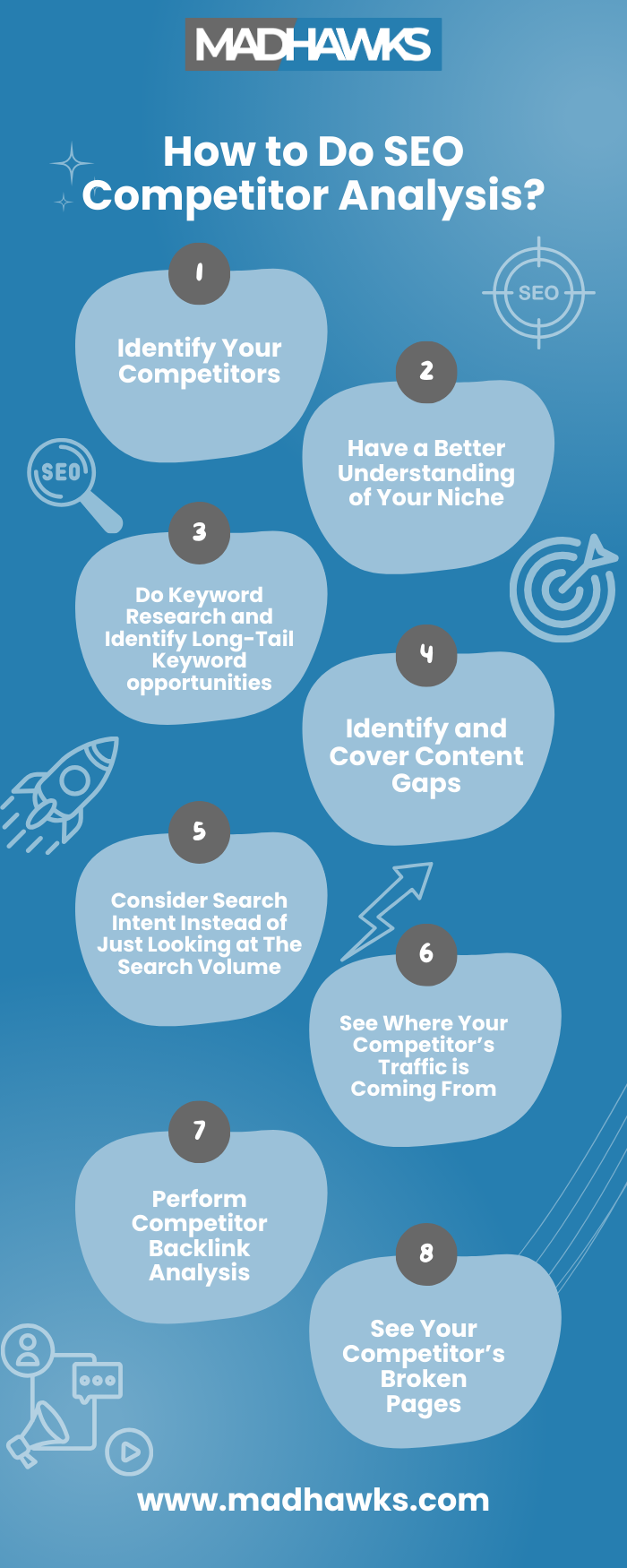Your Guide To Conducting a Complete SEO Competitor Analysis
Posted By Gaurav | 07-May-2024 | Search Engine OptimizationIn order to outrank your competitors, it is essential to understand their strategies first. This is what you can do with SEO competitor analysis. Identifying their strengths and weaknesses enables you to reshape your strategy for better results. With this blog, let us help you understand in detail how you can perform competitor analysis.

You might not realise this your competitors are a massive source of information and strategies that you can use to refine your SEO processes. The digital world is highly competitive and in order to establish a presence in this, you need a strong SEO (Search Engine Optimization) strategy. By looking at the competition in your niche, you may feel demotivated and think that you will never be able to outperform your powerful competitors. But trust us when we say this. You can.
By getting insights into their strategies, understanding their strengths and weaknesses, and identifying ranking opportunities that you are missing out on, you can improve your strategy and maybe even make it to the top of SERPs. All this is possible with proper SEO competitor analysis. Let us quickly dive deeper into what it is and why it matters.
What is SEO Competitor Analysis?

SEO Competitor analysis is the process of digging into your competitor's SEO strategies and gaining insights from them to refine your website’s SEO. This helps you understand your strengths and identify potential areas for improvement. In SEO competitor analysis, you research the keywords, content, backlinks, and other important SEO aspects of your competitors to improve your own strategy.
Why is SEO Competitor Analysis Important?
It is crucial to understand and analyze the SEO strategy of your competitors in order to find out how you can outrank them. You must understand the fact that there are hundreds of websites publishing content around similar keywords. And hundreds of your competitors would have been doing the same.
How can you ensure that your content is visible among the top results? It’s by researching the strategies of your top competitors and learning from them. A good SEO competitor analysis helps you in many ways as follows:
- It helps you identify the powerful strategies of your competitors and improve your own SEO accordingly.
- You can understand their weak areas and take advantage of them to boost your results.
- It helps you learn what works best in your niche.
- You can identify potential mistakes to avoid.
- You can understand how challenging it would be to outrank your competitors.
How to Do SEO Competitor Analysis?

Here is your complete SEO competitor analysis checklist to ensure that you do not miss out on anything that matters:
1. Identify Your Competitors
The first step in conducting a competitor analysis is obviously to identify your competitors. Here, competitors don’t necessarily mean direct competitors who are running the same business as yours. Instead, these are the websites that are ranking for the same keywords that you target. You can identify your top competitors by typing your keywords in Google’s search bar and noting down the names of top-ranking websites in SERPs. An efficient way to do this is to use an organic keyword research tool.
2. Have a Better Understanding of Your Niche
Once you have a list of your competitors, you can move further in the process of understanding your niche more thoroughly. If your competitors’ sites are performing well, it’s a good sign that people are interested in your niche. If not, try to expand your keyword list by including keywords that readers seem to search.
3. Do Keyword Research and Identify Long-Tail Keyword opportunities
The next step is to conduct thorough keyword research and identify potential ranking opportunities. Look at the keywords that your competitors are ranking for. You may find some keywords that you are not yet targeting or ranking for. This helps you understand and fill keyword gaps.
This can also be done using a keyword gap tool where you can enter the URLs of your site along with your competitors and compare their keywords. This process is known as keyword gap analysis. With this, you can take these actions:
- Create new web pages or blogs around keywords that you do not target.
- Optimize existing pages for relevant keywords.
When using an SEO competitor analysis tool like Semrush to identify keyword gaps, keep in mind that all the missing keywords that it shows might not be relevant to your site. What you have to do is identify relevant keywords and prioritize the ones with high ranking potential.
4. Identify and Cover Content Gaps
By looking at the content strategy of your competitors, you can identify potential content gaps or content opportunities that you are missing out on. See what type of content they are creating to drive user engagement and what factors contribute to their success in content. By analyzing their content strategies and learning from them, you can improve your content and build a strategy to outperform your competitors in the SERPs.
5. Consider Search Intent Instead of Just Looking at The Search Volume
One of the biggest mistakes that website publishers make is to ignore user search intent. Instead of just focusing on how many people are searching for a particular keyword, try to also pay attention to their search intent.
Search intent refers to the expectation of a user when they click on a page’s URL. Try to understand how your competitors are fulfilling user’s search intent and optimize your content accordingly. Google now prioritizes user experience and if you do not fulfill users’ search intent, you might not be able to gain good search engine rankings.
6. See Where Your Competitors’ Traffic is Coming From
The best SEO Agency in india is what not only helps you identify content gaps but also offers you insights into the best-performing pages of your competitors. In the content gap report of competitor analysis, you can see a breakdown of traffic coming from different web pages of your competitors. This will help you understand what type of content performs the best in your niche. You can just replicate it in a similar but better way to attract traffic to your website.
7. Perform Competitor Backlink Analysis
Backlink analysis is one of the most crucial steps to take when performing SEO competitor analysis. It helps you understand where your competitors are getting backlinks from, what type of content is getting them backlinks, and a lot more that you can use to refine your backlink strategy in 2024. This will help you identify potential backlink opportunities. You can easily identify relevant websites that allow guest posting, contact publishers that link to your competitors, and politely request them to link to your high-quality content.
8. See Your Competitors’ Broken Pages
This is quite a less popular but effective strategy to outperform your competitors. Under the SEO competitor analysis tools, you can look for broken pages of your competitors and build similar pages to replace them. This gives you an opportunity to rank for potential keywords. Also, you can see all the sites giving backlinks to these broken pages and contact the site publishers to replace their links with yours.
Get Complete SEO Competitor Analysis Done by SEO Experts at MadHawks
SEO competitor analysis holds the utmost importance when it comes to improving your SEO strategies. It not only helps you learn from your competitors’ strategies but also allows you to identify your areas for improvement. There are plenty of SEO competitor analysis tools that you can find online, but to get detailed analysis and drive important insights out of it, you might need the expertise of experienced SEO professionals.
The SEO team at MadHawks understands the importance of SEO competitor analysis and has helped a number of websites improve their SEO strategies. With proper knowledge of tools and techniques used in SEO competitor analysis, our SEO Services can do thorough keyword research, identify content gaps, and improve your SEO strategy in the best way possible. For any further information, contact us today!
FAQs
1. What is the best SEO tool for competitor site analysis?
Ans. Some best SEO tools for competitor site analysis are the Semrush competitor analysis tool and Ahrefs.
2. How to do competitor analysis for SEO?
Ans. You can do SEO competitor analysis using a competitor analysis tool like Semrush and following the below-mentioned steps:
- Identify your competitors
- Do keyword research to identify keyword gaps
- Understand the content strategy of your competitors
- Do competitors’ backlink analysis
- Look for your competitors’ broken pages and try to replace them with yours
3. What is the importance of competitor analysis in SEO?
Ans. Competitor analysis is important in SEO it helps you understand your competitors’ strengths and weaknesses. You can get insights into their strategies and learn from them to improve your site’s SEO.
4. What is competitor link analysis in SEO?
Ans. Competitor backlink analysis refers to analyzing their backlink profile. It involves:
- Looking for websites that are offering backlinks to your competitors
- Looking for the type of content that is driving backlinks
5. How to check competitors' backlinks?
Ans. You can check competitors’ backlink profiles with a competitor backlink analysis tool.

